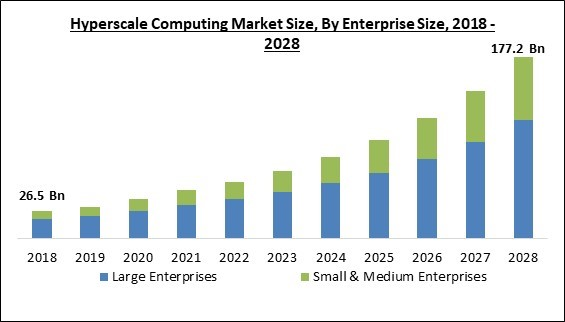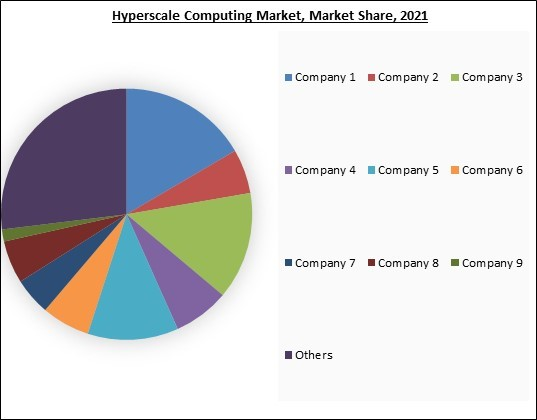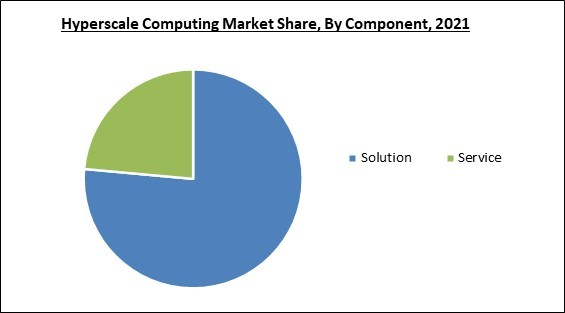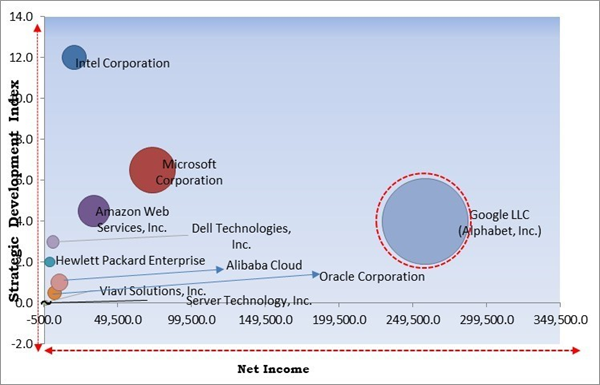The Global Hyperscale Computing Market size is expected to reach $177.2 billion by 2028, rising at a market growth of 21.4% CAGR during the forecast period.
The potential of an infrastructure to scale effectively as system demand rises is known as hyperscale in computing. In a larger computing, grid computing, or distributed computingenvironment, this often involves the flexibility to seamlessly offer and increase computation, networking,storage resources, and memoryto a specific node or set of nodes. Building a strong and scalable cloud, map reduce, distributed storage system or big datarequires hyperscale computing, which is frequently related to the infrastructure needed to support large distributed sites like Google, Amazon, Microsoft, Huawei Cloud, IBM Cloud, or Oracle.
Hyperscale is essentially a distributed computing infrastructure that may grow to thousands of servers. It thus refers to the entire combination of hardware and facilities. Hyperscaleisabout obtaining large computational scale, usually for cloud computing or big data. In order to achieve high levels of throughput, performance,and redundancy to provide high availability and fault tolerance, hyperscale infrastructure is intended for horizontal scalability. Therefore, virtual networking and massively scalable server configurations are frequently used in hyperscale computing.
There are numerous reasons why a company could choose to use hyperscale computing. The best or only means to achieve a business objective, such as offering cloud computing services, may be through hyperscale. Hyperscale solutions typically offer the most economical means of tackling difficult criteria. For instance, the hyperscale's scale and computational density might be the most cost-effective way to handle a big data analytics project.
Large-scale use of computing technologies in businesses is required in the modern world due to developments in the constantly expanding field of IT and the digitization of several operational and business operations. When there is a significant amount of data and accompanying workload, hyperscale computing means establishing a distributed computing system scaling from a few servers to hundreds of servers in an economical manner. Application software like cloud computing and big data frequently use hyperscale computing.
The leading players in the market are competing with diverse innovative offerings to remain competitive in the market. The illustration shows the percentage of revenue shared by some of the leading companies in the market. The leading players of the market are adopting various strategies in order to cater demand coming from the different industries. The key developmental strategies in the market are Partnerships & Collaborations.
The major strategies followed by the market participants are Partnerships. Based on the Analysis presented in the Cardinal matrix; Google LLC is the forerunner in the Hyperscale Computing Market. Companies such as Microsoft Corporation, Intel Corporation, and Amazon Web Services, Inc. are some of the key innovators in Hyperscale Computing Market.
The market research report covers the analysis of key stake holders of the market. Key companies profiled in the report include Amazon Web Services, Inc. (Amazon.com, Inc.), Hewlett Packard Enterprise Company (HP Development Company L.P.), Intel Corporation, Microsoft Corporation, Google LLC (Alphabet, Inc.), Oracle Corporation, Dell Technologies, Inc., Alibaba Cloud (Alibaba Group Holding Limited), Viavi Solutions, Inc., and Server Technology, Inc. (Legrand Group).
The potential of an infrastructure to scale effectively as system demand rises is known as hyperscale in computing. In a larger computing, grid computing, or distributed computingenvironment, this often involves the flexibility to seamlessly offer and increase computation, networking,storage resources, and memoryto a specific node or set of nodes. Building a strong and scalable cloud, map reduce, distributed storage system or big datarequires hyperscale computing, which is frequently related to the infrastructure needed to support large distributed sites like Google, Amazon, Microsoft, Huawei Cloud, IBM Cloud, or Oracle.
Hyperscale is essentially a distributed computing infrastructure that may grow to thousands of servers. It thus refers to the entire combination of hardware and facilities. Hyperscaleisabout obtaining large computational scale, usually for cloud computing or big data. In order to achieve high levels of throughput, performance,and redundancy to provide high availability and fault tolerance, hyperscale infrastructure is intended for horizontal scalability. Therefore, virtual networking and massively scalable server configurations are frequently used in hyperscale computing.
There are numerous reasons why a company could choose to use hyperscale computing. The best or only means to achieve a business objective, such as offering cloud computing services, may be through hyperscale. Hyperscale solutions typically offer the most economical means of tackling difficult criteria. For instance, the hyperscale's scale and computational density might be the most cost-effective way to handle a big data analytics project.
Large-scale use of computing technologies in businesses is required in the modern world due to developments in the constantly expanding field of IT and the digitization of several operational and business operations. When there is a significant amount of data and accompanying workload, hyperscale computing means establishing a distributed computing system scaling from a few servers to hundreds of servers in an economical manner. Application software like cloud computing and big data frequently use hyperscale computing.
COVID-19 Impact Analysis
During the pandemic, cloud computing technology was vital in assisting individuals and organizations by providing a variety of technologies to help research and development efforts for vaccines, treatments, and testing. The data science community led the struggle against the pandemic using AI and ML techniques. However, because complex algorithms typically needed considerable processing ability, they frequently used cloud computing. By offering services, free tools, and financial responsibilities throughout the crisis, many hyperscale computing companies responded to this demand and supported international initiatives. Therefore, the growing use of AI/ML throughout the COVID-19 pandemic increased the need for strong computing technologies, which positively impacted the hyperscale computing market.Market Growth Factors
Known benefits of hyperscale computing increasing reliability
Companies that provide hyperscale computing use cutting-edge hardware and software to guarantee high responsiveness and reliability to consumer demand. In addition, visibility will increase as CO2 emissions decrease as more unmanned hyperscale installations are made possible by virtual monitoring technologies and the Internet. Hyperscale computing's scalable architecture can handle high demand levels. In addition, high-speed data center interconnects (DCIs) enable dispersed computing, which seamlessly spreads the network globally to access resources when data centers reach their capacity constraints. Therefore, these factors are facilitating the use of hyperscale computing by more enterprises and, as such, aid in expanding the market.The leading players in the market are competing with diverse innovative offerings to remain competitive in the market. The illustration shows the percentage of revenue shared by some of the leading companies in the market. The leading players of the market are adopting various strategies in order to cater demand coming from the different industries. The key developmental strategies in the market are Partnerships & Collaborations.
Rising need for high-performance technology and cloud computing
The increased use of technology and consumer preference for the cloud drive demand for cloud-based solutions. The user can receive the data from a distance owing to this technology. In addition, the demand for cloud-based solutions is driven by businesses' growing awareness of how important it is to save money and resources by transferring their data to the cloud. Due to these advantages, major corporations and SMEs embrace cloud-based solutions more frequently. Globally, businesses and government agencies are shifting from using test environments to using the cloud more frequently for mission-critical workloads and compute instances. Hence, in the coming years, the expansion of cloud computing services is enabling market growth.Market Restraining Factors
Higher capital expenditure costs and lack of data control
Hyperscale computing has given businesses less control of their data. Also, it is not possible to add more server or memory space due to the possibility of faults. Employee responsibility and internal management requirements are higher with hyperscale computing, which is a short-term negative. Consumers become reliant on their hyperscale provider's price policy. Each service provider's user interface is unique. Businesses can opt for a hybrid solution to weigh the benefits and drawbacks, using the cloud only to store exceptionally large backups or data that isn't needed frequently. Their own data center has more room for storage as a result. These exorbitant installation costs could limit market demand.Component Outlook
Based on component, the hyperscale computing market is bifurcated into solution and service. The solution segment garnered the highest revenue share in the hyperscale computing market in 2021. The segmentis expanding due to the rising need for scalable computing infrastructuresolutions. This is a result of an increase in the use of IoT as well as other digitalizationsolutions by organizations to gain a strategic and competitive edge along witha healthy customer base over their rivals. Furthermore, these solutions utilize current data investments, save time and money, and enhance image analysis capabilities with just one solution.Enterprise Size Outlook
On the basis of enterprise size, the hyperscale computing market is divided into large enterprises and small & medium enterprises. The small and medium enterprises (SMEs) segment recorded a significant revenue share in the hyperscale computing market in 2021. To improve business processes and save costs, small and medium-sized businesses are increasingly implementing hyperscale innovations, including micro-segmentation,software-defined networking (SDN), and converged infrastructure. Improvements to financial and operational plans, creating and implementing modular infrastructures, and providing centralized distributed data centers to boost agility are a few examples of uses of hyperscale architecture in SMEs.Application Outlook
Based on application, the hyperscale computing market is segmented into cloud computing, big data, IoT, and others. The cloud computing segment witnessed the maximum revenue share in the hyperscale computing market in 2021. The segment's dominance can be due to businesses adopting cloud infrastructure faster. Due to the current business and economic climate, prominent IT and business leaders intend to boost their engagement in cloud-based services. This market's growth is anticipated to be fueled by a rising trend toward using high-performance computing products using the cloudfor processing massive amounts of data quickly, accurately, and with the least latency possible.End-use Outlook
On the basis of end-use, the hyperscale computing market is categorized into BFSI, IT & telecom, media & entertainment, retail & e-commerce, healthcare, and others. The BFSI segment acquired a substantial revenue share in the hyperscale computing market in 2021. Growth is attributable to the increased use of digital technology, online banking, and hybrid cloud computing to enhance customer experience, secure sensitive data, and streamline company processes. In addition, high-performance computer technology use is also anticipated to increase, further boosting this segment's revenue growth.Regional Outlook
Region wise, the hyperscale computing market is analyzed across North America, Europe, Asia Pacific, and LAMEA. The North America region witnessed the largest revenue share in the hyperscale computing market in 2021. The region's market is expanding due to elements like significant research and development (R&D) spending, an established IT services sector, and multiple cloud service providers. Also, the region has a sophisticated technology infrastructure that supports market expansion.The Cardinal Matrix - Hyperscale Computing Market Competition Analysis
The major strategies followed by the market participants are Partnerships. Based on the Analysis presented in the Cardinal matrix; Google LLC is the forerunner in the Hyperscale Computing Market. Companies such as Microsoft Corporation, Intel Corporation, and Amazon Web Services, Inc. are some of the key innovators in Hyperscale Computing Market.
The market research report covers the analysis of key stake holders of the market. Key companies profiled in the report include Amazon Web Services, Inc. (Amazon.com, Inc.), Hewlett Packard Enterprise Company (HP Development Company L.P.), Intel Corporation, Microsoft Corporation, Google LLC (Alphabet, Inc.), Oracle Corporation, Dell Technologies, Inc., Alibaba Cloud (Alibaba Group Holding Limited), Viavi Solutions, Inc., and Server Technology, Inc. (Legrand Group).
Strategies Deployed in Hyperscale Computing Market
Partnerships, Collaborations and Agreements:
- Feb-2023: Amazon Web Services teamed up with Rebura, a UK-based provider of AWS consulting services. The collaboration involves jointly working to broaden their services offerings.
- Jan-2023: Microsoft partnered with OpenAI, a US-based developer of an AI-based research and development platform. The partnership involves working on both the companies' common aim to accelerate AI research and make AI accessible to everyone.
- Oct-2022: Intel collaborated with Google Cloud, a cloud computing services platform by Google. The collaboration includes teaming up to develop a new chip intended to improve data centers' efficiency and safety.
- Jun-2022: Google Cloud came into partnership with Exabeam, a US-based developer of a security intelligence platform. The partnership involves developing hyperscale cloud-native SIEM and cybersecurity analytics offerings. Further, the partnership includes working together to design and develop products that would enable organizations to leverage their data at cloud scale.
- Mar-2022: Microsoft teamed up with Fortum, a Finland-based energy company. The collaboration includes Fortum capturing the excess heat produced by the new data center to be built by Microsoft in Helsinki, Finland. Fortum will transfer the clean heat to business premises, homes and service premises that are connected to its district heating systems.
- Feb-2022: AWS partnered with Kyndryl, an IT infrastructure services provider. The partnership involves advancing cloud adoption and innovation for clients. Together, both the companies would set up a cloud center of excellence to design and develop joint solutions.
- Feb-2022: Hewlett Packard Enterprise came into collaboration with Ayar Labs, a US-based developer of electronic-photonic chipset. The collaboration includes working together to develop data center architectures, working on photonics research and commercial development. Further, the collaboration accelerates innovation for the HPC and AI market.
- Jan-2022: Intel collaborated with GRC, a US-based developer and manufacturer of fluid submersion cooling systems. The collaboration aims to increase data center sustainability. The collaboration further fits well with Intel's vision to support cutting edge technologies that delivers enhanced efficiency. Additionally, the collaboration enables Intel to better serve its clients by providing them with tailor-made solutions to meet their cooling and computing needs.
- Oct-2021: Google Cloud signed an agreement with Thales, a leader in advanced technologies. The agreement includes jointly developing hyperscale cloud offering for France. The new hyperscale offering benefits public sector and French companies. Further, the companies aims to provide innovative and advanced solutions to organizations in France.
- Sep-2020: Intel signed a collaboration agreement with Lightbits Labs, a US-based operator of a software-defined storage company. The agreement includes advancing the development of disaggregated storage solutions to tackle challenges in data center, co-engineering, and capital investment by Intel in Lightbits Labs.
Product Launches and Product Expansions:
- Feb-2020: Dell Technologies introduced EMC PowerEdge XE2420 server. The new short-depth, compact, high performance server is developed to operate in challenging and space-constrained environments. Additionally, the server is equipped with a two socket system, four accelerators to manage evolving business demands, and the option to add up to 92TB of storage per server.
Acquisition and Mergers:
- Apr-2022: Intel took over Granulate, an Israel-based developer of an enterprise platform. The addition of Granulate would result in reduced cloud and infrastructure costs for Intel's cloud and data center clients.
Geographical Expansions:
- Sep-2022: Amazon Web Services expanded its geographical footprint by setting up a new AWS region in Hyderabad, India. The AWS region includes three availability zones, and each zone includes atleast two data centers.
- Aug-2022: Microsoft expanded its geographical footprint by setting up a new data center region in Qatar. The new data center region provides organizations with various highly available, scalable, and resillient cloud services.
- Jun-2022: Oracle opened a new cloud region in Querétaro, Mexico. The new hyperscale cloud region provides vaious services including access to emerging technologies and further allows Mexican organizations, developers and partners to leverage Oracle Cloud Infrastructure (OCI) to improve and expand their businesses.
- May-2022: Alibaba expanded its global footprint by setting up a new data center in Europe. The new data center provides enterprises in Europe with more cloud computing products to choose from.
- Aug-2020: Alibaba Cloud opened three new hyperscale data centers in China. The hyperscale data centers are equipped with Alibaba Cloud's self-developed technologies. The data centers are located in Hangzhou, Nantong and Ulanqab.
Scope of the Study
By Application
- Cloud Computing
- Big Data
- IoT
- Others
By Enterprise Size
- Large Enterprises
- Small & Medium Enterprises
By Component
- Solution
- Service
By End-Use
- IT & Telecom
- Retail & E-commerce
- Media & Entertainment
- Healthcare
- BFSI
- Others
By Geography
- North America
- US
- Canada
- Mexico
- Rest of North America
- Europe
- Germany
- UK
- France
- Russia
- Spain
- Italy
- Rest of Europe
- Asia Pacific
- China
- Japan
- India
- South Korea
- Singapore
- Malaysia
- Rest of Asia Pacific
- LAMEA
- Brazil
- Argentina
- UAE
- Saudi Arabia
- South Africa
- Nigeria
- Rest of LAMEA
Key Market Players
List of Companies Profiled in the Report:
- Amazon Web Services, Inc. (Amazon.com, Inc.)
- Hewlett Packard Enterprise Company (HP Development Company L.P.)
- Intel Corporation
- Microsoft Corporation
- Google LLC (Alphabet, Inc.)
- Oracle Corporation
- Dell Technologies, Inc.
- Alibaba Cloud (Alibaba Group Holding Limited)
- Viavi Solutions, Inc.
- Server Technology, Inc. (Legrand Group)
Unique Offerings
- Exhaustive coverage
- The highest number of Market tables and figures
- Subscription-based model available
- Guaranteed best price
- Assured post sales research support with 10% customization free
Table of Contents
Chapter 1. Market Scope & Methodology
Chapter 2. Market Overview
Chapter 3. Competition Analysis - Global
Chapter 4. Global Hyperscale Computing Market by Application
Chapter 5. Global Hyperscale Computing Market by Enterprise Size
Chapter 6. Global Hyperscale Computing Market by Component
Chapter 7. Global Hyperscale Computing Market by End-Use
Chapter 8. Global Hyperscale Computing Market by Region
Chapter 9. Company Profiles
Companies Mentioned
- Amazon Web Services, Inc. (Amazon.com, Inc.)
- Hewlett Packard Enterprise Company (HP Development Company L.P.)
- Intel Corporation
- Microsoft Corporation
- Google LLC (Alphabet, Inc.)
- Oracle Corporation
- Dell Technologies, Inc.
- Alibaba Cloud (Alibaba Group Holding Limited)
- Viavi Solutions, Inc.
- Server Technology, Inc. (Legrand Group)
Methodology

LOADING...












